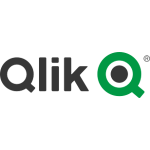About Vertica Analytics Platform
Extract, transform, and load data to Vertica. Ingest data from Vertica and load to other destinations.
About QlikView
As a flexible business intelligence solution, QlikView services over 24,000 organizations around the world. The platform includes easy-to-use BI tools that facilitate the consolidation, searching, and visual analysis of your data for deeper business insights and better decision-making. Perhaps the most popular part of QlikView is the fact that it takes only minutes to learn how to use this highly intuitive platform, which offers an endless variety of querying capabilities without you needing to apply strictly defined structures to your data. Plus, QlikView is neatly packaged in a clean and simple user interface.
Vertica Analytics Platform's End Points
Vertica Massively Parallel Processing (MPP)
Through its MPP architecture, Vertica distributes requests across different nodes. This brings the benefit of virtually unlimited linear scalability.
Vertica Column-Oriented Storage
Veritica's column-oriented storage architecture provides faster query performance when managing access to sequential records. This advantage also has the adverse effect of slowing down normal transactional queries like updates, deletes, and single record retrieval.
Vertica Workload Management Automation
With its workload management features, Vertica allows you to automate server recovery, data replication, storage optimization, and query performance tuning.
Vertica Machine Learning Capabilities
Vertica includes a number of machine learning features in-database. These include 'categorization, fitting, and prediction,' which bypasses down-sampling and data movement for faster processing speed. There are also algorithms for logistic regression, linear regression, Naive Bayes classification, k-means clustering, vector machine regression/classification, random forest decision trees, and more.
Vertica In-Built Analytics Features
Through its SQL-based interface, Vertica provides developers with a number of in-built data analytics features such as event-based windowing/sessionization, time-series gap filling, event series joins, pattern matching, geospatial analysis, and statistical computation.
Vertica SQL-Based Interface
Vertica's SQL based interface makes the platform easy to use for the widest range of developers.
Vertica Shared-Nothing Architecture
Vertica's shared-nothing architecture is a strategy that lowers system contention among shared resources. This offers the benefit of slowly lowering system performance when there is a hardware failure.
Vertica High Compression Features
Vertica batches updates to the main store. It also saves columns of homogenous data types in the same place. This helps Vertica achieve high compression for greater processing speeds.
Vertica Kafka and Spark Integrations
Vertica features native integrations for a variety of large-volume data tools. For example, Vertica includes a native integration for Apache Spark, which is a general-purpose distributed data processing engine. It also includes an integration for Apache Kafka, which is a messaging system for large-volume stream processing, metrics collection/monitoring, website activity tracking, log aggregation, data ingestion, and real-time analytics.
Vertica Cloud Platform Compatibility
Vertica runs on a variety of cloud-based platforms including Google Cloud Platform, Microsoft Azure, Amazon Elastic Compute Cloud, and on-premises. It can also run natively using Hadoop Nodes.
Vertica Programming Interface Compatibility
Vertica is compatible with the most popular programming interfaces such as OLEDB, ADO.NET, ODBC, and JDBC.
Vertica Third-Party Tool Compatibility
A large number of data visualization, business intelligence, and ETL (extract, transform, load) tools offer integrations for Vertica Analytics Platform. For example, Integrate.io's ETL-as-a-service tool offers a native integration to connect with Vertica.
QlikView's End Points
QlikView Qlik Sense Data Analytics Platform
QlikView prides itself on being an 'agent of transformation' for businesses and organizations via the 'Qlik Sense' associative data analytics engine and artificial intelligence technologies. Moreover, the solution's multi-cloud architecture gives you the freedom to deploy whatever combination of on-premises, private cloud, or SaaS you want. Scale to the parameters you require with open APIs, data integration features, and flexible governance. QlikView empowers all team members — regardless of their technical skill levels — to participate in making better, data-driven decisions.
QlikView Data Integration
QlikView acquired Attunity to bring enterprise-level data integration and real-time analytics to its customers via a 'DataOps' approach to data integration. The platform automates data streaming, refinement, cataloging, and publishing to offers real-time data that's ready for analytics.
QlikView Embedded Analytics
QlikView's embedded analytics features allow you to seamlessly embed your QlikView analytics content and interactive dashboards within products, websites, portals, and applications. This empowers users and customers to access important information, metrics, and insights without needing to switch to a separate platform.
QlikView Developer Platforms
QlikView's developer platforms provide the tools your developers need to build, extend, and launch customized, data-driven apps and analytics. The solution offers native, cloud analytics development through the Qlik Core platform — which features an associative engine and open source libraries. This empowers developers to create interactive applications that you can deliver at any scale in any cloud-based architecture.








